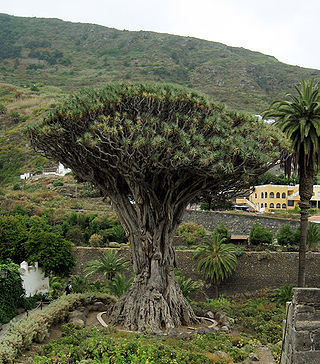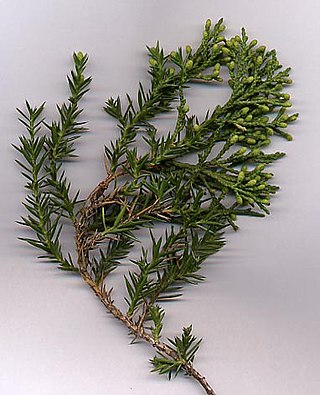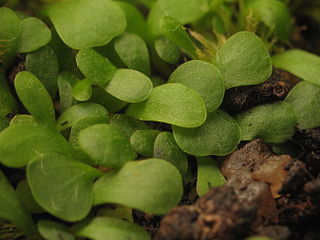
Correa is a genus of eleven species of flowering plants in the family Rutaceae that are endemic to Australia. Plants in the genus Correa are shrubs to small trees with simple leaves arranged in opposite pairs, bisexual flowers with four sepals, four petals usually fused for most of their length and eight stamens.

A daylily or day lily is a flowering plant in the genus Hemerocallis, a member of the family Asphodelaceae, subfamily Hemerocallidoideae, native to Asia. Despite the common name, it is not in fact a lily. Gardening enthusiasts and horticulturists have long bred daylily species for their attractive flowers. Thousands of cultivars have been registered by local and international Hemerocallis societies. Daylilies are perennial plants, whose name alludes to its flowers, which typically last about a day.

Dracaena is a genus of about 120 species of trees and succulent shrubs. The formerly accepted genera Pleomele and Sansevieria are now included in Dracaena. In the APG IV classification system, it is placed in the family Asparagaceae, subfamily Nolinoideae. It has also formerly been separated into the family Dracaenaceae or placed in the Agavaceae.

Koelreuteria paniculata is a species of flowering plant in the family Sapindaceae, native to eastern Asia. It was introduced in Europe in 1747, and to America in 1763, and has become a popular landscape tree worldwide. Common names include goldenrain tree, pride of India, China tree, and the varnish tree.

Agave americana, commonly known as the century plant, maguey, or American aloe, is a flowering plant species belonging to the family Asparagaceae. It is native to Mexico and the United States, specifically Texas. This plant is widely cultivated worldwide for its ornamental value and has become naturalized in various regions, including Southern California, the West Indies, South America, the Mediterranean Basin, Africa, the Canary Islands, India, China, Thailand, and Australia.

Juniperus chinensis, the Chinese juniper is a species of plant in the cypress family Cupressaceae, native to China, Myanmar, Japan, Korea and the Russian Far East. Growing 1–20 metres tall, it is a very variable coniferous evergreen tree or shrub.

Dracaena trifasciata is a species of flowering plant in the family Asparagaceae, native to tropical West Africa from Nigeria east to the Congo. It is most commonly known as the snake plant, Saint George's sword, mother-in-law's tongue, and viper's bowstring hemp, among other names. Until 2017, it was known under the synonym Sansevieria trifasciata.

× Fatshedera is hybrid genus of flowering plants, common name tree ivy or aralia ivy. It has only one species, × Fatshedera lizei. The hybrid symbol × in front of the name indicates that this is an inter-generic hybrid, a cross between plants from different genera. The name may be displayed with or without a space after the × symbol.
The Field Elm cultivar Ulmus minor 'Viminalis Marginata', a variegated form of Ulmus minor 'Viminalis', was first listed as Ulmus campestris var. viminalis marginataHort. by Kirchner in 1864. Both Van Houtte and Späth marketed an U. campestris viminalis marginata in the late 19th century.

The Field Elm cultivar Ulmus minor 'Argenteo-Variegata' or simply 'Variegata', known in Australasia and North America as Silver Elm or Tartan Elm, is said to have been cultivated in France from 1772. Green noted that variegated forms of Field Elm "arise frequently, and several clones may have been known under this name". Dumont de Courset (1802) listed an U. campestris var. glabra variegata, Loudon (1838) an U. nitens var. variegata, and Wesmael (1863) an U. campestris var. nuda microphylla variegata.
The elm cultivar Ulmus 'Argenteo-Marginata' was first mentioned by Deegen in Deutsches Magazin für Garten- und Blumenkund (1879), as Ulmus campestris elegans foliis argenteo-marginatis. An U. campestris fol. argenteo-marginataHort. was distributed by the Späth nursery, Berlin, from the 1890s to the 1930s.

The Field Elm cultivar Ulmus minor 'Viminalis Pulverulenta' (:'powdery'), also known as 'Viminalis Variegata', a variegated form of U. minor 'Viminalis', was first mentioned by Dieck, in 1885 as U. scabra viminalis pulverulentaHort., but without description. Nursery, arboretum, and herbarium specimens confirm that this cultivar was sometimes regarded as synonymous with U. minor 'Viminalis Marginata', first listed in 1864, which is variegated mostly on the leaf margin. It is likely, however, that 'Pulverulenta' was the U. 'Viminalis Variegata', Variegated Twiggy-branched elm, that was listed and described by John Frederick Wood, F.H.S., in The Midland Florist and Suburban Horticulturist 1847 and 1851, pre-dating both Kirchner and Dieck. Wood did not specify the nature of the variegation.

Yucca gloriosa is a species of flowering plant in the family Asparagaceae, native to the southeastern United States. Growing to 2.5 m (8 ft), it is an evergreen shrub. It is widely cultivated as an ornamental for its architectural qualities, and has reportedly become established in warmer climates in the wild in various parts of the world.

Correa reflexa, commonly known as common correa or native fuchsia, is a shrub which is endemic to Australia.

Dracaena fragrans, is a flowering plant species that is native throughout tropical Africa, from Sudan south to Mozambique, west to Côte d'Ivoire and southwest to Angola, growing in upland regions at 600–2,250 m (1,970–7,380 ft) altitude. It is also known as striped dracaena, compact dracaena, and corn plant.

Utricularia livida, the leaden bladderwort, is a species of flowering plant in the bladderwort family, native to central and southern Africa, and Mexico. Growing to 50 cm (20 in) tall and broad, it is a carnivorous perennial. It was originally described and published by Ernst Heinrich Friedrich Meyer in 1837.

Forsythia × intermedia, or border forsythia, is an ornamental deciduous shrub of garden origin.

Hypoestes phyllostachya, the polka dot plant, is a species of flowering plant in the family Acanthaceae, native to South Africa, Madagascar, and south east Asia. The spots often merge into larger areas of colour.

Acer palmatum, commonly known as Japanese maple, palmate maple, or smooth Japanese maple (Korean: danpungnamu, 단풍나무, Japanese: irohamomiji, イロハモミジ, or momiji,, is a species of woody plant native to Korea, Japan, China, eastern Mongolia, and southeast Russia. Many different cultivars of this maple have been selected and they are grown worldwide for their large variety of attractive forms, leaf shapes, and spectacular colors.

Maranta leuconeura, widely known as the prayer plant due to its daily sunlight-dependent movements, is a species of flowering plant in the family Marantaceae native to the Brazilian tropical forests. It is a variable, rhizomatous perennial, growing to 30 cm (12 in) tall and broad, with crowded clumps of evergreen, strikingly-marked oval leaves, each up to 12 cm (5 in) long. The plant spreads itself horizontally, carpeting an entire small area of forest floor, sending roots into the substrate at each leaf node.























